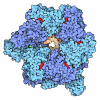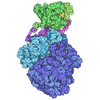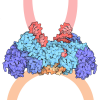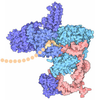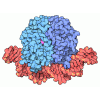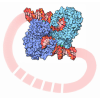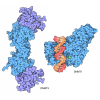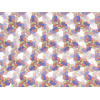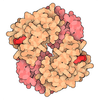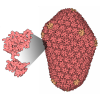[English] 日本語
 Yorodumi
Yorodumi- PDB-9kq2: Cryo-EM structure of RNF168'-RNF168-UbcH5c complex bound to nucleosome -
+ Open data
Open data
- Basic information
Basic information
| Entry | Database: PDB / ID: 9kq2 | ||||||
|---|---|---|---|---|---|---|---|
| Title | Cryo-EM structure of RNF168'-RNF168-UbcH5c complex bound to nucleosome | ||||||
 Components Components |
| ||||||
 Keywords Keywords | DNA BINDING PROTEIN/DNA / DNA repair / Histone ubiquitination / Nucleosome / E3 ubiquitin-protein ligase / RNF168 / DNA BINDING PROTEIN-DNA complex | ||||||
| Function / homology |  Function and homology information Function and homology informationhistone H2AK15 ubiquitin ligase activity / histone ubiquitin ligase activity / double-strand break repair via classical nonhomologous end joining / isotype switching / K63-linked polyubiquitin modification-dependent protein binding / response to ionizing radiation / DNA repair-dependent chromatin remodeling / negative regulation of transcription elongation by RNA polymerase II / protein K63-linked ubiquitination / ubiquitin ligase complex ...histone H2AK15 ubiquitin ligase activity / histone ubiquitin ligase activity / double-strand break repair via classical nonhomologous end joining / isotype switching / K63-linked polyubiquitin modification-dependent protein binding / response to ionizing radiation / DNA repair-dependent chromatin remodeling / negative regulation of transcription elongation by RNA polymerase II / protein K63-linked ubiquitination / ubiquitin ligase complex / interstrand cross-link repair / SUMOylation of DNA damage response and repair proteins / nucleosome binding / positive regulation of DNA repair / epigenetic regulation of gene expression / ubiquitin binding / Nonhomologous End-Joining (NHEJ) / G2/M DNA damage checkpoint / RING-type E3 ubiquitin transferase / double-strand break repair via nonhomologous end joining / ubiquitin-protein transferase activity / structural constituent of chromatin / nucleosome / heterochromatin formation / double-strand break repair / nucleosome assembly / Recruitment and ATM-mediated phosphorylation of repair and signaling proteins at DNA double strand breaks / site of double-strand break / Processing of DNA double-strand break ends / ubiquitin-dependent protein catabolic process / histone binding / protein ubiquitination / protein heterodimerization activity / DNA damage response / chromatin binding / protein-containing complex / DNA binding / zinc ion binding / nucleoplasm / nucleus / cytosol Similarity search - Function | ||||||
| Biological species |  Homo sapiens (human) Homo sapiens (human) | ||||||
| Method | ELECTRON MICROSCOPY / single particle reconstruction / cryo EM / Resolution: 3.9 Å | ||||||
 Authors Authors | Zhu, H.Q. | ||||||
| Funding support |  China, 1items China, 1items
| ||||||
 Citation Citation |  Journal: Nucleic Acids Res / Year: 2025 Journal: Nucleic Acids Res / Year: 2025Title: AlphaFold-guided structural analyses of nucleosome binding proteins. Authors: Xin Yang / Haoqiang Zhu / Liuxin Shi / Tingrui Song / Weibin Gong / Shunmin He / Shan Shan / Chunfu Xu / Zheng Zhou /  Abstract: The nucleosome, as the fundamental unit of chromatin, interacts with a diverse range of proteins, crucially regulating gene expression. In this study, we introduce an AlphaFold-based algorithm ...The nucleosome, as the fundamental unit of chromatin, interacts with a diverse range of proteins, crucially regulating gene expression. In this study, we introduce an AlphaFold-based algorithm designed to analyze nucleosome-binding proteins from a dataset of over 7600 human nuclear proteins. Using proteins that interact with the nucleosome acidic patch as a benchmark, our screening achieves a successful prediction rate of 77% (23 out of 30 proteins). This predictive approach has led to the identification of ARID4A and ARID4B as novel nucleosome-binding proteins. Additionally, this analytical method was used to study RING-family ubiquitin E3 ligase RNF168, demonstrating that RNF168 dimerization enhances its binding to the nucleosome, a finding confirmed by cryogenic-electron microscopy structural analysis. Our findings offer a rapid and effective method for the discovery and characterization of nucleosome-binding proteins and emphasize the significant role of ubiquitin E3 ligase dimerization in epigenetic regulation. | ||||||
| History |
|
- Structure visualization
Structure visualization
| Structure viewer | Molecule:  Molmil Molmil Jmol/JSmol Jmol/JSmol |
|---|
- Downloads & links
Downloads & links
- Download
Download
| PDBx/mmCIF format |  9kq2.cif.gz 9kq2.cif.gz | 296.1 KB | Display |  PDBx/mmCIF format PDBx/mmCIF format |
|---|---|---|---|---|
| PDB format |  pdb9kq2.ent.gz pdb9kq2.ent.gz | 222.9 KB | Display |  PDB format PDB format |
| PDBx/mmJSON format |  9kq2.json.gz 9kq2.json.gz | Tree view |  PDBx/mmJSON format PDBx/mmJSON format | |
| Others |  Other downloads Other downloads |
-Validation report
| Summary document |  9kq2_validation.pdf.gz 9kq2_validation.pdf.gz | 1.2 MB | Display |  wwPDB validaton report wwPDB validaton report |
|---|---|---|---|---|
| Full document |  9kq2_full_validation.pdf.gz 9kq2_full_validation.pdf.gz | 1.2 MB | Display | |
| Data in XML |  9kq2_validation.xml.gz 9kq2_validation.xml.gz | 43.6 KB | Display | |
| Data in CIF |  9kq2_validation.cif.gz 9kq2_validation.cif.gz | 68.1 KB | Display | |
| Arichive directory |  https://data.pdbj.org/pub/pdb/validation_reports/kq/9kq2 https://data.pdbj.org/pub/pdb/validation_reports/kq/9kq2 ftp://data.pdbj.org/pub/pdb/validation_reports/kq/9kq2 ftp://data.pdbj.org/pub/pdb/validation_reports/kq/9kq2 | HTTPS FTP |
-Related structure data
| Related structure data |  62494MC M: map data used to model this data C: citing same article ( |
|---|---|
| Similar structure data | Similarity search - Function & homology  F&H Search F&H Search |
- Links
Links
- Assembly
Assembly
| Deposited unit | 
|
|---|---|
| 1 |
|
- Components
Components
-Protein , 5 types, 9 molecules AEBFCGDHK
| #1: Protein | Mass: 15303.930 Da / Num. of mol.: 2 Source method: isolated from a genetically manipulated source Source: (gene. exp.)  #2: Protein | Mass: 11263.231 Da / Num. of mol.: 2 Source method: isolated from a genetically manipulated source Source: (gene. exp.)  #3: Protein | Mass: 13978.241 Da / Num. of mol.: 2 Source method: isolated from a genetically manipulated source Source: (gene. exp.)  #4: Protein | Mass: 13524.752 Da / Num. of mol.: 2 Source method: isolated from a genetically manipulated source Source: (gene. exp.)  #7: Protein | | Mass: 11802.692 Da / Num. of mol.: 1 Source method: isolated from a genetically manipulated source Source: (gene. exp.)  Homo sapiens (human) / Gene: RNF168 / Production host: Homo sapiens (human) / Gene: RNF168 / Production host:  References: UniProt: Q8IYW5, RING-type E3 ubiquitin transferase |
|---|
-DNA chain , 2 types, 2 molecules IJ
| #5: DNA chain | Mass: 45138.770 Da / Num. of mol.: 1 Source method: isolated from a genetically manipulated source Source: (gene. exp.)  Homo sapiens (human) Homo sapiens (human)Production host:  |
|---|---|
| #6: DNA chain | Mass: 45610.043 Da / Num. of mol.: 1 Source method: isolated from a genetically manipulated source Source: (gene. exp.)  Homo sapiens (human) Homo sapiens (human)Production host:  |
-Non-polymers , 1 types, 2 molecules 
| #8: Chemical |
|---|
-Details
| Has ligand of interest | Y |
|---|---|
| Has protein modification | Y |
-Experimental details
-Experiment
| Experiment | Method: ELECTRON MICROSCOPY |
|---|---|
| EM experiment | Aggregation state: PARTICLE / 3D reconstruction method: single particle reconstruction |
- Sample preparation
Sample preparation
| Component | Name: RNF168'-RNF168-UbcH5c-nucleosome complex / Type: COMPLEX / Entity ID: #1-#7 / Source: RECOMBINANT |
|---|---|
| Source (natural) | Organism:  Homo sapiens (human) Homo sapiens (human) |
| Source (recombinant) | Organism:  |
| Buffer solution | pH: 7.5 |
| Specimen | Embedding applied: NO / Shadowing applied: NO / Staining applied: NO / Vitrification applied: YES |
| Vitrification | Cryogen name: ETHANE / Humidity: 100 % |
- Electron microscopy imaging
Electron microscopy imaging
| Experimental equipment |  Model: Titan Krios / Image courtesy: FEI Company |
|---|---|
| Microscopy | Model: TFS KRIOS |
| Electron gun | Electron source:  FIELD EMISSION GUN / Accelerating voltage: 300 kV / Illumination mode: FLOOD BEAM FIELD EMISSION GUN / Accelerating voltage: 300 kV / Illumination mode: FLOOD BEAM |
| Electron lens | Mode: BRIGHT FIELD / Nominal defocus max: 2300 nm / Nominal defocus min: 1800 nm |
| Image recording | Electron dose: 50 e/Å2 / Film or detector model: GATAN K3 (6k x 4k) |
- Processing
Processing
| EM software | Name: PHENIX / Category: model refinement |
|---|---|
| CTF correction | Type: NONE |
| 3D reconstruction | Resolution: 3.9 Å / Resolution method: FSC 0.143 CUT-OFF / Num. of particles: 58069 / Symmetry type: POINT |
 Movie
Movie Controller
Controller


 PDBj
PDBj
